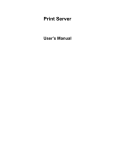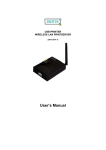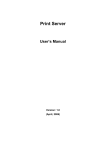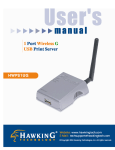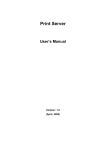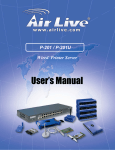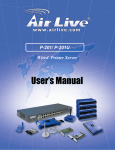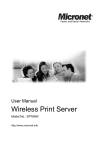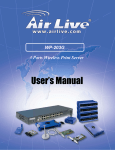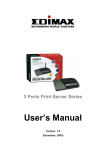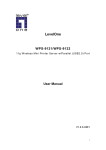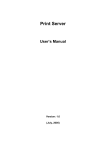Download Intellinet 509060 print server
Transcript
1-Port USB Wireless Print Server user manual Model 509060 INT-509060-UM-0508-01 Thank you for purchasing the INTELLINET NETWORK SOLUTIONS™ 1-Port USB Wireless Print Server, Model 509060. Designed to work with any access point or peer-to-peer wireless network, this server connects any USB printer to your network and is compatible with all major operating systems. Its 10/100 Mbps Ethernet network port connection lets you operate wired or wireless, and its pocket size makes it an easy fit in portable tool kits. The easy-to-follow instructions in this user manual help make setup and operation relatively simple. NOTE: Some screen images have been modified to fit the format of this manual. safety & compliance statements This equipment has been tested and found to comply with the limits for a Class B digital device, pursuant to Part 15 of the FCC (Federal Communication Commission) Rules. These limits are designed to provide reasonable protection against harmful interference in a residential installation. This equipment generates, uses and can radiate radio frequency energy and, if not installed and used in accordance with the instructions, may cause harmful interference to radio communications. However, there is no guarantee that interference will not occur in a particular installation. If this equipment does cause harmful interference to radio or television reception, which can be determined by turning the equipment off and on, the user is encouraged to try to correct the interference by one or more of the following measures: • Reorient or relocate the receiving antenna. • Increase the separation between the equipment and the receiver. • Connect the equipment to an outlet on a circuit different from the receiver. • Consult the dealer or an experienced radio/TV technician for help. FCC Caution This equipment must be installed and operated in accordance with provided instructions, and a minimum of 20 cm spacing must be provided between the computer-mounted antenna and a person’s body (excluding hands and feet) during wireless modes of operation. As this device complies with Part 15 of the FCC Rules, operation is subject to the following two conditions: 1) This device may not cause harmful interference; and 2) this device must accept any interference received, including interference that may cause undesired operation. Any changes or modifications not expressly approved by the party responsible for compliance could void the authority to operate equipment. FCC Radiation Exposure Statement This equipment complies with FCC RF radiation exposure limits set forth for an uncontrolled environment. To avoid the possibility of exceeding these limits, human proximity to the antenna shall not be less than 20 cm (8 inches) during normal operation. The antenna(s) used for this transmitter must not be co-located or operating in conjunction with any other antenna or transmitter. R&TTE Compliance Statement This equipment complies with all the requirements of Directive 1999/5/EC of the European Parliament and the Council of March 9, 1999, on radio equipment and telecommunication terminal equipment (R&TTE) and the mutual recognition of their conformity. The R&TTE directive repeals and replaces Directive 98/13/EEC (Telecommunications Terminal Equipment and Satellite Earth Station Equipment) as of April 8, 2000. EU Countries Intended for Use The ETSI version of this device is intended for home/office use in Austria, Belgium, Denmark, Finland, France, Germany, Greece, Ireland, Italy, Luxembourg, the Netherlands, Portugal, Spain, Sweden and the U.K., and is also authorized for use in EFTA member states Iceland, Liechtenstein, Norway and Switzerland. (EU countries not intended for use: none.) SAFETY & COMPLIANCE Contents 1. Introduction................................................................................................................... 6 1.1 Network Printing Architecture...................................................................................... 6 1.1.1 Print Server Network Functions....................................................................... 6 1.1.2 Network Printing Functions for Clients............................................................ 6 1.1.3 Network Printing Functions for a Network Server........................................... 7 1.2 Network Printing Environment..................................................................................... 8 2. Hardware Installation.............................................................................................. 9 3. Windows Peer-to-Peer Network............................................................................ 9 3.1 System Architecture..................................................................................................... 9 3.2 Administrator Installation and Setup.......................................................................... 10 3.3 Administrator Utilities................................................................................................. 13 3.4 Client Installation and Setup...................................................................................... 14 3.5 Client Utilities............................................................................................................. 16 3.5.1 Network Ports Quick Setup.......................................................................... 17 3.5.2 Remote Ports Utility..................................................................................... 17 3.6 Windows Add Printer Procedure............................................................................... 19 3.6.1 Windows Vista.................................................................................................. 19 3.6.2 Windows XP..................................................................................................... 22 4. Windows NT/2000/Server 2003 Network.............................................................. 24 4.1 System Architecture................................................................................................... 24 4.2 Windows NT/2000/Server 2003 Server Installation and Setup................................. 24 4.3 User Installation......................................................................................................... 25 5. NetWare Network...................................................................................................... 26 5.1 System Architecture.................................................................................................. 26 5.2 NetWare 3.x/4.x/5.x Installation & Setup................................................................... 26 5.2.1 Installation Using PCONSOLE..................................................................... 26 6. UNIX System Network................................................................................................ 28 6.1 Introduction................................................................................................................ 28 6.2 Enable Print Server’s TCP/IP Support...................................................................... 28 6.3 Set Up the Print Server’s IP Address........................................................................ 28 6.3.1 DHCP........................................................................................................... 28 6.3.2 BOOTP......................................................................................................... 28 6.4 Verify the Print Server’s IP Address.......................................................................... 29 6.5 Configure Remote LPD Printing on the Host............................................................. 29 7. Configuration Utility............................................................................................... 30 7.1 Introduction................................................................................................................ 30 7.2 Search for All Available Print Servers........................................................................ 31 7.3 Status of the Print Server........................................................................................... 32 7.4 Set Up the Print Server.............................................................................................. 33 7.5 General Configuration................................................................................................ 34 7.6 TCP/IP Configuration................................................................................................. 34 7.7 NetWare Print Server Configuration.......................................................................... 35 7.8 AppleTalk Configuration............................................................................................. 35 7.9 Bonjour Configuration................................................................................................ 36 7.10 SNMP Configuration.................................................................................................. 36 7.11 SMB Configuration.................................................................................................... 36 7.12 System Configuration................................................................................................ 37 7.13 Wireless Configuration.............................................................................................. 38 CONTENTS 7.14 Wizard......................................................................................................................... 43 7.15 Report.......................................................................................................................... 46 8. Web Management......................................................................................................... 46 8.1 Introduction.................................................................................................................. 46 8.2 Login........................................................................................................................... 46 8.3 Device Status............................................................................................................. 47 8.3.1 System.......................................................................................................... 47 8.3.2 Printer........................................................................................................... 47 8.3.3 TCP/IP.......................................................................................................... 48 8.3.4 SMB.............................................................................................................. 48 8.3.5 SNMP........................................................................................................... 49 8.3.6 NetWare....................................................................................................... 49 8.3.7 AppleTalk...................................................................................................... 50 8.3.8 Bonjour......................................................................................................... 50 8.4 Setup Wizard............................................................................................................. 51 8.4.1 System.......................................................................................................... 51 8.4.1.1 Admin Password............................................................................. 51 8.4.1.2 Advanced Settings......................................................................... 52 8.4.2 Wireless........................................................................................................ 52 8.4.2.1 Site Survey..................................................................................... 53 8.4.2.2 Encryption...................................................................................... 54 8.4.3 TCP/IP.......................................................................................................... 56 8.4.4 SMB.............................................................................................................. 57 8.4.5 SNMP........................................................................................................... 58 8.4.6 NetWare....................................................................................................... 58 8.4.7 AppleTalk...................................................................................................... 59 8.4.8 Bonjour......................................................................................................... 60 8.4.9 Save Settings............................................................................................... 60 8.5 System Tools............................................................................................................. 61 8.5.1 Load Default.................................................................................................. 61 8.5.2 Upgrade Firmware from Browser.................................................................. 61 8.5.3 Backup Setting.............................................................................................. 62 8.5.4 Restore System............................................................................................ 62 8.5.5 Language...................................................................................................... 63 9. Telnet Management.................................................................................................... 63 9.1 9.2 9.3 9.4 9.5 Introduction................................................................................................................... 63 Login...... ....................................................................................................................... 63 Get Setting Values – The ‘get’ Command................................................................... 64 Modify Setting Values – The ‘set’ Command.............................................................. 66 Other Commands........................................................................................................ 67 10. IPP Printing................................................................................................................... 68 10.1 10.2 Introduction................................................................................................................. 68 System Setup............................................................................................................ 68 10.2.1 Print Server Side........................................................................................... 68 10.2.2 Client Side..................................................................................................... 68 11. Windows XP SP2 Setup. ........................................................................................................70 12. specifications . ...................................................................................................................... 74 CONTENTS 1. introduction 1.1 Network Printing Architecture By first introducing the roles of a print server, client user and network server in the network-printing environment, this section illustrates how the 1-Port USB Wireless Print Server — often referred to subsequently simply as “the print server” — functions and operates on the network. Before you install and use the print server, it is strongly recommended that you read this section completely, then select only the chapters you Network Printing Environment need according to your network Network Server Print Server operating system. Client User The print server provides a complete network printing solution, including Unix Print Server NetWare ServerWindows NT Server peer-to-peer printing (PTPP), TCP/IP (LPR), IPP printing, NetWare bindery Windows NT Windows 2000 Windows 98 printing, AppleTalk Workstation and SMB printing. 1.1.1 Print Server Network Functions Because the 1-Port USB Wireless Print Server supports IPX/SPX, NetBEUI, TCP/IP and AppleTalk network protocols, any networked computer can directly print to it through any of its installed protocols. 1.1.2 Network Printing Functions for Clients The 1-Port USB Wireless Print Server provides a PTPP (peer-to-peer printing) driver and utilities for Windows 95/98SE/Me/NT/2000/XP/Server 2003/ Vista users. PTPP supports the TCP/IP protocol. Print Server Unix INTRODUCTION NetWare ServerWindows NT Server Windows NT Windows 2000 Windows 98 Workstation Client User Unix Windows NT Windows 2000 Windows 98 Workstation Print Server Print Server NetWare ServerWindows NT Server In the client installation procedure, after the PTPP driver is installed in Windows, the system will automatically (manual configuration is also allowed) search all the print servers on the network and then add their printing ports into Windows’ printing port (see below). PTPP Windows 98 P1 P1 P2 P3 Print Server MIS-2 Print Server MIS-1 UNIX (including HP/UX, SCO Unix, SunOS, Solaris, Unixware DECUnix, IBM AIX and others) and Linux use the system-standard LPR to print through the print server. MAC OS can use the system-standard AppleTalk network to print through the print server. Network Server 1.1.3 Network Printing Functions for a Network Server The 1-Port USB Wireless Print Server provides a PTPP driver and utilities for Windows NT/2000/ Server 2003/Vista. After PTPP is installed, the server can directly print through the print server. Adding this printing function to Windows allows many advanced features to be used, such as print queue and user authority management. Unix Print Server NetWare ServerWindows NT Server Windows NT Windows 2000 Windows 98 Workstation In a NetWare environment, the 1-Port USB Wireless Print Server offers various printing modes, such as print queue, remote printer, etc. INTRODUCTION 1.2 Network Printing Environment In a Windows peer-to-peer network, the client’s PTPP driver will use the TCP/IP protocol to print through the print server. In a Windows NT/2000/Server 2003/Vista network, the network printing function will become available after the PTPP driver is installed in Windows. As stated earlier, adding this printing function allows many advanced features to be used, such as print queue and user authority management. In a NetWare network, the 1-Port USB Wireless Print Server offers various printing modes, such as print queue, remote printer, etc. INTRODUCTION 2. hardware installation 1. Unpack the 1-Port USB Wireless Print Server package and verify that all the items listed in the Package Contents section of the Specifications are provided. 2. Connect the print server to the printer you want to share on the network. 3. Connect the print server to your network by attaching the network cable to the UTP port of the print server. 4. Connect the power adapter to the print server. The print server will perform the Power-On-Self-Test (POST) after it is turned on. During the POST, the Status LED will be on. When the LEDs are unlighted, the print server is ready. NOTE 1: Only use the power adapter shipped with the print server. Do NOT use any other power adapter from any other sources. NOTE 2: To avoid a compatibility problem between the 1-Port USB Wireless Print Server and some printers, it is recommended that you turn on power to the 1-Port USB Wireless Print Server before turning on the printer. 3. windows peer-to-peer network 3.1 System Architecture The print server supports Windows’ Peer-to-Peer Network Printing mode, which is suitable for most medium and small network environments. The installation procedure is separated into two parts: 1. Administrator Installation and Setup (refer to section 3.2 for more detailed info). System administrators must: • Install the administrator’s utilities into his/her computer. • Configure the print server from the administrator’s configuration utility. 2.Client Installation and Configuration (refer to section 3.3 for more detailed info). Client users must: •Install a Windows PTPP driver for network printing. In addition, after PTPP is installed, the system will automatically search for all print servers on the network and add the printing port of the print servers into Windows’ printing port (refer to Network Printing Architecture in section 1.1 for more detailed information). HARDWARE INSTALLATION / WINDOWS PEER-TO-PEER NETWORK 3.2 Administrator Installation and Setup The Administrator Installation can be performed on Windows 98SE/Me/NT/2000/ XP/Server 2003/Vista with the same user interface. Before the installation, verify that your network protocol is installed on your PC (TCP/IP, IPX and/or NetBEUI). It will be helpful in your installation process. Insert the CD included with the print server into your CD-ROM drive. The Autorun.exe program should be executed automatically. If not, run Autorun.exe manually from the CD-ROM drive’s root directory. The Installation Manager will be displayed on the screen (shown at right). Click “Administrator Installation.” The “Utilities Setup” window will be displayed. Click “Next.” Click “Next” to install the utilities in the default folder, or click “Browse” to specify the destination folder where you would like to install the utilities. 10 WINDOWS PEER-TO-PEER NETWORK Select the components you want to install. It is highly recommended that you install all of the provided components. Click “Next” to continue. Specify the program folder where the program icons will be added. Click “Next.” The system will start to install the utilities automatically. WINDOWS PEER-TO-PEER NETWORK 11 At this point, the installation phase is complete. You can prepare to configure the print server. The “Choose Print Server” field will list all print servers within the network. Select the print server you would like to configure and click “Next.” NOTE 1: If this is the first time you configure the print server, the “Print Server Name” is the last 6 digits of the MAC ID with the prefix “PS.” Check the MAC ID on the print server. NOTE 2: The list can only display the devices from the same manufacturer. Specify a recognizable name for the print server and click “Next.” Specify the IP address for the print server manually or click “Next” to keep the default IP address: 192.168.2.2. 12 WINDOWS PEER-TO-PEER NETWORK The configuration summary is displayed.Now, you have completed the print server setup. Click Finish” and your system will add a network port of the print server to your PC automatically. At this point, the administrator installation procedure is done. Click “Finish.” The Administrator Installation program performs the following tasks: • Installs all utilities and drivers to the administrator’s PC. • Configures the print server (including the print server name and network protocol). • Adds the network port of the print server to the administrator’s PC. If you want to print from this administrator’s PC to the print server, all you need to do is to perform Windows’ standard Add Printer procedure (refer to Section 3.6). 3.3 Administrator Utilities After the Administrator Installation program is completed, there will be four utilities in the print server’s Program folder. Network Ports Quick Setup – Adds the network ports of print servers within the network to your PC. Print Server Configuration – Allows you to configure the print server’s IP address, network protocols and other advanced functions. (Refer to Chapter 7 for detailed instructions for the configuration.) Remote Ports – Adds the network port of a remote printer server to your PC. WINDOWS PEER-TO-PEER NETWORK 13 Uninstall – This “assistant” serves to remove all installed administrator software. 3.4 Client Installation and Setup The Client Installation program can be performed on Windows 98SE/Me/NT/2000/ XP/Server 2003/Vista with the same user interface. Before starting the installation procedure, confirm that your PC has connected to the network and has installed at least one network protocol. Insert the included CD into your CD-ROM drive. The Autorun.exe program should be executed automatically. If not, run Autorun.exe manually from the CD-ROM drive’s root directory. The Installation Manager will be displayed on the screen (shown at right). Click “Client Installation.” The “Utilities Setup” window will be displayed. Click “Next.” 14 WINDOWS PEER-TO-PEER NETWORK Click “Next” to install the utilities in the default folder, or click “Browse” to specify the destination folder where you would like to install the utilities. Specify the program folder where the program icons will be added; click “Next.” The system will start to install the utilities automatically. WINDOWS PEER-TO-PEER NETWORK 15 Now that the installation procedure is complete, you are ready to set up the client’s computer. All network ports of the print servers detected on the network will be added to your PC automatically. Click “Continue.” The Client Installation procedure is complete. Click “Finish.” With this installation, the following tasks have been completed: • Installation of all utilities and drivers to the client’s PC. • Addition of all the print server’s network ports of the network to the client’s PC. You can then perform Windows’ standard Add Printer procedure to add network printers to your PC. (Refer to Section 3.6.) 3.5 Client Utilities When Client Installation is complete, there will be three tools in the print server’s Program folder: Network Ports Quick Setup, Remote Ports and Uninstall Network Driver. Uninstall Network Driver will assist you in removing all installed client software; the other two tools are described below. 16 WINDOWS PEER-TO-PEER NETWORK 3.5.1 Network Ports Quick Setup The Network Ports Quick Setup utility offers a very simple method to add or remove the print server’s printer port from the client’s computer. During the client’s installation procedure, the system will automatically search for all print servers on the network and add them into the printer ports of the client’s computer (shown at right). If you have just installed another new print server in the network, you must run this program first. This program will search for new print servers and allow you to add the new network printer port into the client’s computer conveniently. By performing the standard Add Printer procedure, you can then print directly to the printer through the newly installed print server. Be aware that Network Ports Quick Setup utility can only detect and configure all print servers on the same network: It cannot search and configure print servers on other subnets across network segments. You must use the Remote Ports utility described in the next section to manage remote (across network segments) print servers. 3.5.2 Remote Ports Utility The Remote Ports utility offers a convenient way fto manage and add a printer port of the remote print server. From the assistant of this utility, you can print to other print servers outside the subnet across a network segment. Note, however, that this function only supports the TCP/IP network protocol. WINDOWS PEER-TO-PEER NETWORK 17 1.Run the Remote Ports utility. Click “Add” to add a remote printer port. 2.Enter the print server’s name and IP address, select the ports used and enter the LPR queue name of each port. Click “OK.” 3.The new remote printer port is displayed. In order to use the remote printing function, you need to proceed with the normal Add Printer procedure and select your printer port as the newly added remote printer port. 18 WINDOWS PEER-TO-PEER NETWORK 3.6 Windows Add Printer Procedure After adding a network port of the print server to your PC using the Administrator or Client Installation program, you can follow the procedure described below to add a printer to Windows. NOTE: The following Add Printer steps are in Windows Vista and XP: The steps in other operating systems are similar. 3.6.1 Windows Vista 1.Click “Start” and select “Settings\Printers.” 2.Click “Add a Printer.” 3.The Add Printer wizard is displayed. Select “Add a local printer.” 4.Choose the suitable printer port created during the installation process and click “Next.” WINDOWS PEER-TO-PEER NETWORK 19 5.Select the printer manufacturer and the printer model and click “Next.” If your printer isn’t on the list, click “Have Disk…” to install the driver of the printer. After installation, the printer model will be added to the list. 6.Name your printer and set the default printer; then click “Next.” 7.The printer drivers are being installed. 20 WINDOWS PEER-TO-PEER NETWORK 8.It is recommended that you print a test page. Then click “Finish.” 9.The printer is added to the Printers screen, indicating that you have added the printer to your computer successfully. Now you can start to print from your computer to the print server. WINDOWS PEER-TO-PEER NETWORK 21 3.6.2 Windows XP 1.On the desktop, go to Start, then Settings: select “Printers and Faxes.” 2.Click “Add a Printer.” 3.The Add Printer Wizard” screen is displayed. Click “Next.” 4.Select “Local printer attached to this computer” and make sure that “Automatically detect and install my Plug and Play printer” is not selected. Click “Next.” 5.Choose the suitable “Print Server Network Port” created during the Administrator Installation or Client Installation process and click “Next.” 22 WINDOWS PEER-TO-PEER NETWORK 6.Select a suitable printer manufacturer and the printer model and click “Next.” If your printer isn’t on the list, click “Have Disk…” to install the driver of the printer. After installation, the printer model will be added to the list. 7.Name your printer and set up the default printer; then click “Next.” 8.It is recommended that you print a test page. Then click “Next.” WINDOWS PEER-TO-PEER NETWORK 23 9.You have now successfully added the printer to the PC. Information about the printer is displayed on screen. Click “Finish.” 4. windows nt/2000/server 2003 network 4.1 System Architecture In a Windows network environment, in addition to the Peer-to-Peer network printing architecture described in the previous chapter, the 1-Port USB Wireless Print Server also offers the server-based printing architecture for Windows NT/2000/ Server 2003. Only one Windows NT/2000/Server 2003 workstation is required to have the Windows PTPP (Peer-to-Peer Printing) driver installed — it can share the printing service on the network so other network users can simply connect to the server and access the shared printer (see below). 4.2 Windows NT/2000/Server 2003 Installation and Setup The following procedure is for the installation and construct of a peer-to-peer connection (PTPP) between Windows NT/2000/Server 2003 and the print server. 1.If this is your first time installing the print server, install the administrator software on Windows NT/2000/Server 2003 first. (Refer to section 3.2 for installation instructions.) 24 NT/2000/SERVER 2003 If your network has already installed a working print server and your Windows NT/2000/Server 2003 has not yet installed the PTPP driver, install the client software. (Refer to section 3.4 and 3.5 for installation instructions.) 2.Add/configure the Peer-to-Peer Printing of the Windows NT/2000/Server 2003 network printer and verify that you can print from Windows NT/2000/Server 2003 to the print server through the installed PTPP driver. 3.Connect the above server’s printer to the network by performing the standard Windows printer sharing process. 4.3 User Installation After the server side’s installation is complete, the client side will be able to find the server’s shared printer in Network Neighborhood. You only need to perform Window’s standard Add New Printer procedure, select “Network Printer” (as shown at below right), and complete the configurations afterward to access the shared printer. NT/2000/SERVER 2003 25 5. netware network 5.1 System Architecture A NetWare printer sharing functionality has been integrated into the 1-Port USB Wireless Print Server itself, thus allowing one or more printers attached by a print server to be connected to the network. (The 1-Port USB Wireless Print Server supports the NetWare print server.) This embedded print server emulates the “queue management functionality” of a NetWare print server (the PSERVER program running on the NetWare server). A user first prints a job at a workstation, the job is routed to a NetWare server, the NetWare server stores the job in a print queue and then the print server gets the print job from the queue to printers. Print Queue Windows 98 Netware Server Print Server Windows 2000 Compared with NetWare printing functionality, the advantages of embedding the NetWare network printing functionality in the 1-Port USB Wireless Print Server include: • Installation is easier and quicker. • Network management is easier. • Printing performance is enhanced. • The NetWare file server’s burden is lessened. • The need for a workstation running the remote printer utility is removed. • Productivity is improved by locating the printer near the workgroup. Each print server should log in to a NetWare server before servicing the print jobs, and each print server will occupy a user account with which it can log in to the NetWare server. 5.2 NetWare 3.x/4.x/5.x Installation & Setup Once your print server is connected to your Ethernet network, you can set it up for use with your networking software. 5.2.1 Installation Using PCONSOLE (Configuring as Print Server Mode) 1.Run the NetWare PCONSOLE program. 2. Change the current file server, if necessary, using the “Change Current File Server” menu selection. 3. Choose the “Print Queue Information” menu selection. 4. Press the Insert key to add a new print queue. 5. Enter a print queue name, such as “PQ” or “Q1.” 26 NT/2000/SERVER 2003 6.You’ve now successfully created the print queue that your print server will serve. Press the Escape key until the Available Options main menu is displayed. 7.Select “Print Server Information.” 8.Press the Insert key to add a new NetWare print server object. The print server name can be identical to the PSxxxxxx name printed on the label of the print server. 9.Press Enter to select the newly created print server. 10.Select “Print Server Configuration.” 11.Select “Printer Configuration.” 12.Select “Printer 0” (or “Printer 1,” “Printer 2”) and press Enter, then select “P1” (or “P2,” “P3”) in the “Type” field. NOTE: If your print server has only one port, you do not need to configure this field. 13.Press Escape, and answer “Yes” to the “Save Changes?” prompt. 14.Select “Queues Serviced by Printer,” then select “Printer 0” (or “Printer 1,” “Printer 2”) and press Enter. 15.Press Insert and add your newly created print queue to the list of queues serviced by the printer. Enter a priority number for the queue service, or press Enter to accept the default. 16.Repeatedly press Escape to exit the PCONSOLE program. 17. Reset the print server so the changes take effect. NOTE: If the print server you have has multiple printer connectors, you may create multiple print queues and printer objects. Your print server should now be ready to use. You should be able to redirect printing to your print server using a CAPTURE command such as the one shown in the previous section. NT/2000/SERVER 2003 27 6. UNIX System Network 6.1 Introduction The print server is available for TCP/IP printing by Unix LPD (Line Printer Daemon) protocol. The LPD protocol, which originated with the Unix release, is based on the BSD version of Unix and is supported under most versions of Unix. This chapter explains how to configure the print server for TCP/IP operation, and how to modify configuration files on your Unix system to allow printing to the print server. The configuration examples in this manual follow the syntax for BSD-based Unix systems. Refer to the related system documentation for the correct syntax of your systems. The five steps below, which are detailed in the following sections, show how to configure the print server for LPD printing. 1.Enable the print server’s TCP/IP support. 2.Set up the print server’s IP address. 3.Verify the print server’s IP address. 4.Configure remote LPD printing on the host. 5.Print a test page. 6.2 Enable the Print Server’s TCP/IP Support The default configuration of the print server is set with TCP/IP support enabled. You can configure the print server to enable TCP/IP support using the configuration program. 6.3 Set Up the Print Server’s IP Address The print server must have a unique IP address in order to be recognized by the network. You can set up the IP address on the various Unix systems using either: • DHCP (Dynamic Host Configuration Protocol) or • BOOTP (Bootstrap Protocol) 6.3.1 DHCP There are many Unix systems that support the DHCP protocol, and the procedures to configure the DHCP server database are different. This manual does not describe the DHCP server configuration on the Unix systems. It is highly recommended that the DHCP server should be located on the same network as the print server. 6.3.2 BOOTP If you have the BOOTP daemon, bootpd, running on your UNIX system that is accessible by the print server, you can use the BOOTP protocol to set up the IP address of the print server. It’s recommended that the BOOTP server should be located on the same subnet as the print server. If you use Network Information Services (NIS) in your system, you may need to rebuild the NIS map with the BOOTP services before doing the following BOOTP configuration. To rebuild the NIS map, refer to your system documentation. To configure the IP address data for the BOOTP server, you will need to log in the host of the BOOTP server as the superuser (root). Perform the following steps to add address entries. 28 UNIX 1.Optionally, assign a name corresponding to the print server’s IP address. You can add this address to the /etc/hosts file by adding a line such as: 203.66.191.12 pserver 2.Add an entry to the host’s /etc/bootptab file, similar to the following: hostname:\ :ht=1:\ :ha=print_server_ethernet_address:\ :ip=print_server_ip_address: Lines should be indented with tabs. Where the hostname is the device name of a print server, the ht=1 tag specifies the hardware type is Ethernet; the ha= tag specifies the Ethernet address of a print server, which is the node ID located on the print server. The ha tag must be preceded by the ht tag. The ip= tag should correspond to the IP address you want to assign to the print server. For example, for a print server with the following configuration: •Node ID: 0000B4010101 (this implies the Ethernet address is 0000B4010101), •IP address: 203.66.191.12 the entry for this print server in the /etc/bootptab file should be: PS010101:\ :ht=1:\ :ha=0000B4010101:\ :ip=203.66.191.12: 6.4 Verify the Print Server’s IP Address To verify that your print server is responding to the newly assigned IP address using a PING command: ping ip-address 6.5 Configure Remote LPD Printing on the Host The procedure you use to configure your Unix host(s) to allow printing to your network remote print server varies among different varieties of Unix. The procedure below can be used for Unix variants that are related to BSD Unix, such as SunOS or Linux. For other versions of Unix, consult your system documentation, keeping in mind that: •The print server should be treated as a BSD-networked print server host. •The hostname should be the name (or IP address) that you have assigned to the print server. •The printer name (or queue name) on the remote host should be p1, p2 or p3 — the name of the printer port on the print server. You will need to perform the tasks below, logged in as the superuser (root). To configure your Unix host for printing, 1.Optionally, assign a name corresponding to the print server’s IP address. You can add this address to the /etc/hosts file, by adding a line such as: 203.66.191.186 pserver 2. Create a spool directory for the printer in the same directory where spool directories are normally kept on the machine, such as /var/spool or /var/spool/lpd: UNIX 29 mkdir /var/spool/lpd/pserverd chown daemon /var/spool/lpd/pserverd chgrp daemon /var/spool/lpd/pserverd chmod 775 /var/spool/lpd/pserverd 3.Add an entry to the host’s /etc/printcap file, similar to the following: printer-name:\ :lp=:\ :rm=203.66.191.186:\ :rp=p1:\ :lf=/var/spool/lpd/pserverd.log:\ :sd=/var/spool/lpd/pserverd:\ :mx#0: Lines should be indented with tabs. More than one printer name can be used, with variants separated by vertical bars (name1|name2). The rm= entry should correspond to the IP address you have assigned to the print server. You can also use a hostname if you’ve assigned one in the /etc/hosts file. The sd= entry should correspond to the spool directory you created in the previous step. The rp= entry should correspond to the port name of the remote printer. The values should be one of p1, p2 or p3, depending on the printer port. The print server should now be available for printing from your Unix host. 7. Configuration Utility 7.1 Introduction This chapter introduces the print server’s system configuration utility in a Windows environment. This utility is automatically installed during the Windows Administrator utility installation procedure (refer to sections 3.2 and 3.3). This utility provides the most complete management and configuration functions on the print server side. This utility only provides configuration functions for the print server itself; it does not include configuration functions for the client side or other file servers or NetWare servers in the network environment. The Configuration utility provides the following configuration and management functions (with detailed subsections that follow): • Search Print Server: Search all available printer servers on the network. • Print Server Status: Display print server network status. • General Configuration: General information about the print server. • TCP/IP Configuration: IP address and DHCP server configuration. • NetWare Configuration: NetWare printing configuration. • AppleTalk Configuration: AppleTalk protocol settings. • Bonjour Configuration: Mac OSX protocol settings. • SMB: Configure the SMB group name. • SNMP Configuration: SNMP information configuration. • Setup Wizard: Guide to all the settings. • System Configuration: Print server network ability settings, firmware upgrades and language settings. • Wireless Configuration: Wireless LAN configuration. • Report: List the status of all available print servers on the network. 30 CONFIGURATION UTILITY 7.2 Search for All Available Print Servers Whenever you run the print server’s configuration utility, click on the Search icon (left) on the tool bar. The configuration utility will be delayed for several seconds because the utility is using the system’s available network protocols to search for all print servers on the network. All available print servers will be listed under “Server Group” on the left side of the screen. Select the print server you would like to configure from the list. The system will, at the same time, display the selected print server’s status on the right side of the screen. CONFIGURATION UTILITY 31 7.3 Status of the Print Server Click on the Status icon (left) on the tool bar to show the status of the current selected print server on the right side of the screen. Information displayed about the print server includes MAC ID, model type, firmware version, status of each printer port, NetWare file server name, NetWare file server polling interval, NetWare printer queue names, IP address, subnet mask, default gateway, AppleTalk printer type, AppleTalk zone and print server printing ability. Refresh the print server’s status by clicking on the Refresh icon (far left). Restart the print server by clicking on the Reboot icon (near left). 32 CONFIGURATION UTILITY 7.4 Set Up the Print Server Click on the Setup icon on the tool bar to show the setup items of the current selected print server on the right side of the screen. Double-click one of the icons to set up the selected print server. A screen will display to verify the user name and password of the print server. The default values are as follows. • User Name: admin • Password: 1234 CONFIGURATION UTILITY 33 7.5 General Configuration Double-click on the General icon and the General configuration screen will display. You can see basic print server information on this screen. You also can configure the server name, username and password here. Server Name is the name of the print server. You can use this name to identify the print server when you are searching for the print server using the administration and client utilities. User Name / Password is used to authenticate the administrator using the Web administration tool. 7.6 TCP/IP Configuration Double-click on the TCP/IP icon and the TCP/IP configuration screen will display. You can configure the print server to automatically get an IP address from DHCP server or manually specify a static IP. The print server also has a built-in DHCP server. You can enable this DHCP server and let it manage IP addresses for you. Click “IP” to enter the IP settings page. If you need the print server to automatically get an IP address from the DHCP server, select “Auto IP.” You also can select “Static IP” to manually assign an IP address, subnet mask and gateway for the print server. Click “DHCP Server” to enter the DHCP server’s settings page. You can enable/disable the DHCP server, or set to “Auto” and assign a range of IP addresses here. The DHCP server is disabled by default. 34 CONFIGURATION UTILITY If “Auto” is selected, the DHCP server of the print server will be enabled only when there is no other DHCP server within the network. When “Enable” or “Auto” is selected, you need to configure starting address, range, subnet mask, gateway and DNS. The print server will assign a unique IP address for each client. 7.7 NetWare Print Server Configuration Double-click on the NetWare icon and the NetWare configuration screen will display. This print server supports NetWare Bindery Printing. The print server periodically polls the NetWare server printer queues for printing jobs. You need to assign the NetWare server name, print server polling interval and the name of the queue on the NetWare server for each printer port. Polling Time is the polling interval of the print server waiting for printing jobs on the NetWare server. Queue Serviced by Printer is the name of the printer queue on the NetWare server. The printer queue keeps all printing jobs waiting on the NetWare server. You need to assign a printer queue for each printer port of this print server. NetWare Server is the name of the NetWare file server that provides printer queues. 7.8 AppleTalk Configuration Double-click on the AppleTalk icon and the AppleTalk configuration screen will display. AppleTalk is a data communication protocol often used by Macs. The print server can use these parameters to join the AppleTalk network and share the printer to other AppleTalk workstations. You need to set up the zone name and printer type for each printer port of this print server. Zone Name: The print server has to join zones of AppleTalk before it can be shared with other workstations: Only workstations in the same zone can share the printer. To share the printer with all workstations in all zones, enter only an asterisk (*) in the “Zone Name” field. Printer Type is the type of printer attached to each printer port. You can get the printer type from the manufacturer of the printer. CONFIGURATION UTILITY 35 7.9 Bonjour Configuration Bonjour enables automatic discovery of computers, devices and services on an IP network. The service name will be seen by users on the IP network, so choose a unique (but recognizable!) name to describe the device. 7.10 SNMP Configuration Double-click on the SNMP icon and the SNMP configuration window will display. Contact: You can enter the print server administrator’s contact information here. This information will be displayed in the SNMP management tool. Location: You can enter the installed location of the print server here. This information will be displayed in the SNMP management tool. 7.11 SMB Configuration SMB Group Name is the name of SMB group that this print server belongs to. All PCs should join the same group before they can use this print server using the SMB protocol. 36 CONFIGURATION UTILITY 7.12 System Configuration Double-click on the System icon and the System configuration window will display. On the System configuration screen, you can enable/disable each printing or management protocol, assign a name for each printer port of this print server, upgrade the new firmware for this print server and enable/disable the wireless function. Port Name is the name of the printer port. Each printer port has to be assigned a name. The client utility uses this name to access the printer port. Upgrade Firmware: You can use this Upgrade Firmware tool to update the newest firmware of the print server. Click and select the correct firmware in your PC. After selecting the firmware file, click “Upgrade” to finish the firmware update process. If you want to reset the print server to the default factory settings, click “Load Default.” Wireless Function: You can select “Enable” or “Disable” to manually enable or disable the wireless function. If you manually enable the wireless function, the print server’s wireless LAN will be always enabled and Ethernet will be always disabled. CONFIGURATION UTILITY 37 If you manually disable the wireless function, the print server’s wireless LAN will be always disabled and Ethernet will be always enabled. You also can select “Auto” to let the print server automatically decide to enable or disable the wireless function. The print server only can work in ether Ethernet or wireless LAN mode: It cannot work in both Ethernet and wireless LAN mode at the same time. When the print server starts up, it will auto-detect if the LAN port is connected to an active network by an Ethernet cable. If the print server is connected to an active network through an Ethernet cable when starting up, the print server will run in Ethernet mode. If the print server is not connected to an active network by Ethernet cable when starting up, the print server will run in wireless LAN mode. The print server default is in “Auto” mode. Domain Country: The wireless channels vary from country to country. Generally, the channels are from 1 to 11 in the U.S. and from 1 to 13 in Europe. The operating channel will be set to the print server before importing. If you are in a different locale, make sure that you have set the available channels according to your location. 7.13 Wireless Configuration If you want to use the print server through a wireless LAN, set up the print server through Ethernet first and make sure your wireless LAN setting is correct. After setting the wireless LAN, unplug the Ethernet cable and restart the print server; then you can start to use the print server through the wireless LAN. NOTE: If the wireless configuration doesn’t work, plug the Ethernet cable in again, restart the print server and configure the print server through Ethernet until the wireless LAN settings are correct. The default settings of the print server wireless function are as follows. • Mode: Infrastructure • SSID: Default • Channel: 11 38 CONFIGURATION UTILITY Double-click on the Wireless icon and the wireless configuration window will display. If you use access points to create a wireless network, Infrastructure mode is used. After selecting the operation modes of the wireless function, click “Next” to display detailed configuration information. Infrastructure Mode In Infrastructure mode, you need to let the print server associate with an access point. The print server can scan for an available access point automatically or you can manually assign the SSID of the access point you want to use. If you elect to let the print server scan for an available access point, the screen at right will display. The list is of the scanned available access points. Select an access point on the list and click “Next.” If you can’t find the access point that you want to use, click “Scan” to let the print server scan again. The following procedures are necessary to continue with the configuration of the Infrastructure mode settings. CONFIGURATION UTILITY 39 This print server supports WEP, WPA-PSK and WPA2-PSK security modes. To use WEP encryption to protect your wireless network, select “WEP(ASCII)” or “WEP(HEX).” To use WPA-PSK, select “WPA-PSK.” To use WPA2-PSK, select “WPA2-PSK.” The wireless security setting should be the same on other wireless devices in the same network. WEP Security Mode Select “64 bit” or “128 bit” length and “Hexadecimal” or “ASCII” format for the encryption key. NOTE: A longer key length can provide stronger security, but at the expense of communication performance. 40 CONFIGURATION UTILITY Enter four key values using the guidelines below and select one key as the default key. PassPhrase: A passphrase simplifies the WEP encryption process by automatically generating the WEP encryption keys for the print server. This setting is only valid when the security mode is “WEP(HEX).” Key 1 — Key 4: If the key length is 64-bit, enter 10-digit Hex values or 5-digit ASCII values as the encryption keys. For example: “0123456aef” or “Guest.” If the key length is 128-bit, enter 26-digit Hex values or 13-digit ASCII values as the encryption keys. For example: “01234567890123456789abcdef” or “administrator.” WPA-PSK Mode “WPA-PSK” requires users to select the advanced encryption methods — TKIP or AES — and enter a set of shared keys. CONFIGURATION UTILITY 41 TKIP: The Temporal Key Integrity Protocol (TKIP) changes the temporal key every 10,000 packets. This ensures much greater security than standard WEP security. AES: AES has been developed to ensure the highest degree of security and authenticity for digital information. It’s the most advanced solution defined by IEEE 802.11i for security in the wireless network. Pre-shared Key Format: Select “Passphrase” or “Hex” key format. If “Passphrase” is selected, enter 8 to 63 digits of ASCII format as the key for authentication within the network. If “Hex” is selected, enter 64 digits of Hex code (“0-9” and “A-F”). WPA2-PSK Mode “WPA2-PSK” requires that you select the advanced encryption methods — TKIP or AES — and enter a set of shared keys. AES: AES has been developed to ensure the highest degree of security and authenticity for digital information. It’s the most advanced solution defined by IEEE 802.11i for security in the wireless network. Key: Enter 8 to 63 digits of ASCII format as the key for authentication within the network. When you finish configuring the wireless security, click “Next” to continue. You can elect to let the print server automatically obtain IP settings with DHCP Client or to manually assign the IP settings. If you manually assign the IP settings, you need to enter the IP address, subnet mask and default gateway address. When you finish configuring the IP settings, click “Next” to confirm the IP address configuration. 42 CONFIGURATION UTILITY Click “Save” to save the wireless configuration. 7.14 Wizard Click on the Wizard icon (left) on the tool bar to display the setup wizard item of the current selected print server on the right side of the screen. Doubleclick on the Print Server Setup Wizard and the setup wizard will guide you through the entire setup process. CONFIGURATION UTILITY 43 1.Set up the name of this print server and the port name for the print server, and choose to enable or disable the wireless function. 2.Select/enable the required printing protocol (refer to section 7.12 for details). 3.Set up the IP address of this print server and the DHCP server (refer to section 7.6 for details). 44 CONFIGURATION UTILITY 4.Set up the NetWare printing (refer to section 7.7 for details). 5.Select the Wireless Adapter mode and complete the wireless LAN settings. NOTE: The other procedures are the same as the “Wireless” settings on the Setup screen (refer to section 7.13 for details). 6.Click “Save” to finish the procedure. CONFIGURATION UTILITY 45 7.15 Report Click on the Report icon (left) on the tool bar to display the Report screen. The report lists basic information about all available print servers on the network, including device name, MAC ID, model type, firmware version and the status of the print server. 8. web management 8.1 Introduction The 1-Port USB Wireless Print Server can be configured and managed on the Web. Through a local area network, or even the Internet, an administrator can easily configure and manage the print server’s various main functions in browsers. Simply enter the print server’s IP address into your browser’s address field to manage a print server using the print server’s built-in Web server. The default IP address, username and password settings of the print server are as follows. • IP Address: 192.168.2.2 • User Name: Admin • Password: 1234 8.2 Login You can use any Web browser to review the status or configure the settings of the print server. After entering the IP address of the print server, a login page displays (right). Make the correct entries in the “User Name” and “Password” fields, then proceed to the Web Management pages. 46 WEB MANAGEMENT 8.3 Device Status 8.3.1 System System Information includes the device name, print server name, model type, system up time, firmware version, MAC address and the status of the protocols enabled. 8.3.2 Printer This screen lists information about the printer connected to the printer port. WEB MANAGEMENT 47 8.3.3 TCP/IP This screen lists all TCP/IP settings of the print server, including the IP address, subnet mask and gateway. It also lists DHCP server settings. 8.3.4 SMB This screen lists the SMB group settings of the print server. 48 WEB MANAGEMENT 8.3.5 SNMP This screen lists the SNMP settings of the print server, including the SNMP system contact and SNMP system location. SNMP System Community: To enter the name of the system group. The default name is “public.” SNMP System Manager IP: The IP address for the trap alarm. SNMP Trap: There are two levels to choose from: v1 and v2. 8.3.6 NetWare This screen lists NetWare settings, including polling time, Bindery mode settings, name of the file server and port attached queue. WEB MANAGEMENT 49 8.3.7 AppleTalk This screen lists AppleTalk settings, including the AppleTalk zone name and the type of printers connected to all print ports. 8.3.8 Bonjour This screen lists Bonjour settings, including the port service name of each port. 50 WEB MANAGEMENT 8.4 Setup Wizard 8.4.1 System You can change the print server name and port name of the print server from here. Print Server Name is the name of the print server. You can use this name to identify the print server when you are searching for the print server by the administrator and client utilities. Port Name is the name of the printer port. Each printer port has to be assigned a name to be used to access the printer port. 8.4.1.1 Admin Password This screen allows you to change the password of the print server. WEB MANAGEMENT 51 Name is the administrator name of the print server. If you change the name, you need to log in to the print server from the administrator utility or Web management with the new name. The default user name is “admin.” Password: Enter the password you want to change for the print server. The password can be up to an 8-digit alphanumeric format. The default password is “1234.” Re-type Password: Enter the password you want to change for the print server again. 8.4.1.2 Advanced Settings This screen allows you to enable/disable the printing protocol. To enable the function, select “Enable”; to disable the function, select “Disable.” 8.4.2 Wireless If you want to use the print server through a wireless LAN, set up the print server through the Ethernet first and make sure your wireless LAN setting is correct. After setting the wireless LAN, unplug the Ethernet cable and restart the print server. You can then start to use the print server through the wireless LAN. If the wireless configuration doesn’t work, plug the Ethernet cable in again, restart the print server and configure the print server through the Ethernet until the wireless LAN settings are correct. You can set parameters that are used for the wireless stations — including Function and ESSID — to connect to this print server. You can manually set the parameters of a wireless LAN on this screen or use the Site Survey function to automatically search for an available access point and associate with it. Mode is the operation mode of wireless station. If you’re using an access point in the wireless LAN infrastructure, the wireless mode is Infrastructure. ESSID is the unique name identifying a wireless LAN. The ID prevents the unintentional merging of two co-located WLANs. Make sure that the ESSID of all 52 WEB MANAGEMENT stations and access points in the same WLAN network is the same. Channel Number is the channel number of your wireless LAN. The channel number is set to “11.” 8.4.2.1 Site Survey This screen allows you to search for available access points in your location. On the list is information about all available access points or wireless stations, including SSID, BSSID, channel, type, encryption and signal strength. You can select one wireless device on the list for this print server to associate with. WEB MANAGEMENT 53 8.4.2.2 Encryption This print server supports WEP, WPA-PSK and WPA2-PSK security modes. To use WEP encryption to protect your wireless network, select “WEP.” To use WPAPSK, select “WPA-PSK.” To use WPA2-PSK, select ‘’WPA2-PSK.’’ The wireless security setting should be the same for other wireless devices in the same network. WEP Security Mode Key Length: Choose “64-bit” to use WEP with 64-bit key length encryption; choose “128-bit” to use WEP with 128-bit key length encryption. NOTE: A longer key length can provide stronger security, but at the expense of throughput. Key Format: Use ASCII characters (alphanumeric format) or hexadecimal digits (in the “A-F,” “a-f” and “0-9” ranges) for the WEP key. PassPhrase: A passphrase simplifies the WEP encryption process by automatically generating the WEP encryption keys for the print server. Default Key: Select one of the four keys to encrypt your data. Only the key you select in the “Default key” drop-down menu will take effect. Key 1 – Key 4: The WEP keys are used to encrypt data transmitted within the wireless network. If the key length is 64-bit, enter 10-digit Hex values or 5-digit ASCII values as the encryption keys. For example: “0123456aef” or “Guest.” If the key length is 128-bit, enter 26-digit Hex values or 13-digit ASCII values as the encryption keys. For example: “01234567890123456789abcdef” or “administrator.” 54 WEB MANAGEMENT WPA-PSK Security Mode “WPA-PSK” requires that you select one of the advanced encryption methods — TKIP or AES — and enter a set of shared keys. TKIP: The Temporal Key Integrity Protocol (TKIP) changes the temporal key every 10,000 packets. This ensures much greater security than standard WEP. AES: AES has been developed to ensure the highest degree of security and authenticity for digital information. It’s the most advanced solution defined by IEEE 802.11i for security in the wireless network. Pre-shared Key Format: Select “Passphrase” or “Hex” key format. If “Passphrase” is selected, enter 8 to 63 digits of ASCII format as the key for the authentication within the network. If “Hex” is selected, enter 64 digits of Hex code (“0-9” and “A-F”). Pre-Shared Key: Enter your encryption code in this field. WEB MANAGEMENT 55 WPA2-PSK Security Mode “WPA2-PSK” requires that you enter shared keys with AES algorithms only. AES: AES has been developed to ensure the highest degree of security and authenticity for digital information. It’s the most advanced solution defined by IEEE 802.11i for security in the wireless network. Pre-shared Key Format: Select “Passphrase” or “Hex” key format. If “Passphrase” is selected, enter 8 to 63 digits of ASCII format as the key for the authentication within the network. If “Hex” is selected, enter 64 digits of Hex code, (“0-9” and “A-F”). When you finish configuring the wireless security, click “Save & Next” to confirm the configuration. 8.4.3 TCP/IP 56 WEB MANAGEMENT You can configure the print server to automatically get an IP address from the DHCP server, or to manually specify a static IP address. The print server also has a built-in DHCP server. You can enable this DHCP server and let it manage the IP process for you. If you need the print server to automatically get an IP address from the DHCP server, select “Enable Obtain TCP/IP Settings Automatically (Use DHCP/ BOOTP).” You also can select “Disable Use the following TCP/IP Settings” to manually assign an IP address, subnet mask and gateway for the print server. You can enable/disable or set to “Auto” for the print server’s DHCP server. The DHCP server is disabled by default. If the DHCP server is enabled or set to “Auto,” you need to assign a range of IP addresses here. Fill in the “Start IP,” “Range,” “DNS,” “Subnet Mask” and “Gateway” fields, and the print server will assign a unique IP for each client. NOTE: When “Auto” is selected, the DHCP server of the print server will be enabled only when there is no other DHCP server within the network. 8.4.4 SMB You can enable/disable the SMB protocol from here. If SMB is enabled, enter the SMB group name to specify the SMB group that this print server belongs to. All PCs should join the same group before they can use this print server using the SMB protocol. Furthermore, you can enable the “Pass Job When Error Occurred’’ function and enter the time length (1-60 seconds) in the “Waiting time to pass job’’ field. WEB MANAGEMENT 57 8.4.5 SNMP The print server supports SNMP configuration. If it’s enabled, set up the following parameters. SNMP System Contact: You can enter the print server administrator’s contact information here. This information will be displayed in the SNMP management tool. SNMP System Location: You can enter the installed location of the print server here. This information will be displayed in the SNMP management tool. SNMP System Community: To enter the name of the system group. The default name is “public.” SNMP System Manager IP: The IP address for the trap alarm. SNMP Trap: There are two levels to choose from: v1 and v2. 8.4.6 NetWare This print server supports the NetWare Bindery Printing method. The print server 58 WEB MANAGEMENT periodically polls the NetWare server printer queues for printing jobs. You have to assign the NetWare server name, print server polling interval and the name of queue on the NetWare server for each printer port. Polling Time is the polling interval of the print server for waiting printing jobs on the NetWare server. Name of the File Server is the name of the NetWare file server that provides printer queues. Attached Queue is the name of the printer queue on the NetWare server. The printer queue keeps all printing jobs waiting on the NetWare server. You need to assign a printer queue for each printer port of this print server. 8.4.7 AppleTalk AppleTalk is a data communication protocol often used by Macs. The print server can use these parameters to join the AppleTalk network and share the printer to other AppleTalk workstations. You need to either enable or disable AppleTalk and set up the zone name and printer type for each printer port of this print server. AppleTalk Enable: Enable or disable AppleTalk. AppleTalk Zone Name: The print server has to join zones of AppleTalk before it can be shared with other workstations. Only workstations in the same zone can share the printer. If you want to share the printer with all workstations in all zones, enter only and asterisk (*) in the “Zone Name” field. Printer Type is the type of printer attached to each printer port. You can get the printer type from the manufacturer of the printer. WEB MANAGEMENT 59 8.4.8 Bonjour Bonjour enables automatic discovery of computers, devices and services on an IP network. The service name will be seen by users on the IP network, so choose a unique (but recognizable!) name to describe the device. 8.4.9 Save Settings Click “Save Settings” to save the settings and restart the system. 60 WEB MANAGEMENT 8.5 System Tools 8.5.1 Load Default You can use this screen to restore the factory default settings. All of your previous setup will be cleared. 8.5.2 Upgrade Firmware from Browser You can upgrade new firmware for the print server on this screen. Browse Click “Browse” to select the new firmware in your storage, then click “OK.” The firmware will be updated in several minutes. NOTE: Once you’ve started upgrading the firmware, you need to follow all the upgrading steps or the print server can’t return to its normal configuration. WEB MANAGEMENT 61 8.5.3 Backup Settings To back up the print server settings to a “config.bin” file, select “Backup settings from Print Server.” 8.5.4 Restore System To apply the settings from the backup file, select “Restore settings from file” and specify a file to restore. Browse 62 WEB MANAGEMENT 8.5.5 Language To apply the language you want to use, select “TW” for Chinese or “EN” for English; then click “OK.” . 9. telnet management 9.1 Introduction The 1-Port USB Wireless Print Server an be configured and managed by Telnet. Through a local area network, or even over the Internet, an administrator can easily configure and manage the print server’s various main functions using a Telnet client tool. 9.2 Login Execute the Telnet client tool and connect to the print server’s IP address: telnet 192.168.2.2 You’ll then be prompted to enter the username and password. After you enter the correct username and password, an “admin#” prompt will be displayed, indicating that you can start to manage the print server by command. TELNET MANAGEMENT 63 9.3 Get Setting Values – The ‘get’ Command The “get” command (formatted as: get argument [value] — see the table below) is used to get the setting values of the print server. For example, to get the IP address of the print server, type the “get ip” command after the “admin#” prompt. The IP value “IP_ADDR=’192.168.2.2’” will be displayed: admin# get ip IP_ADDR=’192.168.2.2’ If you enter “get” only, the system will list all available arguments for the “get” command, as presented in the following table. Argument Description Example psname password username wlfunc wlmode ESSID channel wep defkey key641 key642 key643 key644 key1281 key1282 key1283 key1284 ip gateway 64 Print server name admin# get psname PORT1_PS=’PS254896’ Login password admin# get password USER_PASSWORD=’1234’ Login username admin# get username USER_NAME=’admin’ Wireless LAN function is enabled admin# get wlfunc or disabled WIRELESS_FUNCTION=2 0: disabled 1: enabled 2: auto Wireless LAN mode is admin# get wlmode Infrastructure AP_MODE=1 0: Infrastructure ESSID of the wireless LAN admin# get ESSID SSID=’default’ Channel number used by wireless admin# get channel LAN CHANNEL=11 The mode of WEP admin# get wep 0: disable WEP=0 1: 64 bit WEP enabled 2: 128 bit WEP enabled Default WEP key number admin# get defkey 0: key 1 WEP_DEFAULT_KEY=0 1: key 2 2: key 3 3: key 4 64 bit WEP key 1 admin# get key641 WEP64_KEY1=0123456789 64 bit WEP key 2 admin# get key641 WEP64_KEY2=0123456789 64 bit WEP key 3 admin# get key641 WEP64_KEY3=0123456789 64 bit WEP key 4 admin# get key641 WEP64_KEY4=0123456789 128 bit WEP key 1 admin# get key1281 WEP128_KEY1=0123456789 abcdef0123456789a 128 bit WEP key 2 admin# get key1282 WEP128_KEY2=0123456789 abcdef0123456789a 128 bit WEP key 3 admin# get key1283 WEP128_KEY3=0123456789 abcdef0123456789a 128 bit WEP key 4 admin# get key1284 WEP128_KEY4=0123456789 abcdef0123456789a IP of the print server admin# get ip AP_ADDR=’192.168.2.2’ Default gateway of the print server admin# get gateway DEFAULT_ GATEWAY=’192.168.2.254’ TELNET MANAGEMENT submask polling Subnet mask of the print server aq1 applezone printertype1 admin# get aq1 PORT1_QNAME=’PQ1’ admin# get applezone PORT1_APPLEAONE=’*’ admin# get printertype1 PORT1_ PRINTTYPE=’LaserWriter’ The name of the SMB group admin# get SMBDG name that this print server joins to SMBD_NAME=’default’ The administrator contact admin# get SNMPC information of this print server for SNMP_CONTACT=’sbdjohn@ SNMP hotmail.com’ The installed location of this print admin# get SNMPL server for SNMP SNMP_LOCATION=’Room 301’ The port name of this print server admin# get port1 PORT1_LPTNAME=’��� p�� 1’ The DHCP server is enabled or admin# get DHCPS disabled DHCPD=0 0: disable 1: enable Get dynamic IP by DHCP is admin# get DHCP enabled or disabled DYNAMIC_IP=0 0: disable 1: enable AppleTalk printing is enabled or admin# get appletalk disabled APPLE_ENABLE=0 0: disable 1: enable SMB printing is enabled or admin# get SMBD disabled SMBD_ENABLE=1 0: disable 1: enable SNMP management protocol is admin# get SNMP enabled or disabled SNMP_ENABLE=1 0: disable 1: enable NetWare Bindery printing is admin# get IPX enabled or disabled IPX_ENABLE=1 0: disable 1: enable LPR printing is enabled or admin# get LPD disabled LPD_ENABLE=1 0: disable 1: enable IPP printing is enabled or disabled admin# get IPP 0: disable IPP_ENABLE=1 1: enable RAW printing is enabled or admin# get RAW disabled RAW_ENABLE=1 0: disable 1: enable SMBDG SNMPC SNMPL port1 DHCPS DHCP appletalk SMBD SNMP IPX LPD IPP RAW Polling interval (in second) of the print server for waiting printing jobs on the NetWare server Name of the printer queue on the NetWare server The name of AppleTalk zone that this print server joins to The type of the printer attached to this print server admin# get submask SUBNET_MASK=’255.255.255.0’ admin# get polling PORT1_POLLTIME=3 TELNET MANAGEMENT 65 9.4 Modify Setting Values – The ‘set’ Command The “set” command (formatted as: set argument [name value] — see the table below) is used to modify the print server setting values, which will be written into the system configuration. For example, if you want to set the IP address of the print server to 192.168.2.2, type “set ip 192.168.2.2” and the IP address of the print server will be changed. After the setting is finished, reboot the print server (admin# reboot). If you enter “set” only, the system will list all available arguments for the “get” command, as presented in the following table. Argument psname password username wlfunc wlmode ESSID channel wep defkey key641 key642 key643 key644 key1281 key1282 key1283 key1284 ip gateway submask 66 Description Print server name Login password Login username Enable or disable the wireless LAN function. The value should be “disabled,” “enabled” or “auto” Wireless LAN mode is Infrastructure�. The value should be “inf” ESSID of the wireless LAN Channel number used by wireless LAN. The mode of WEP. The value should be “disable,” “wep64” or “wep128” Default WEP key number. The value should be 0–3. 0: key 1 1: key 2 2: key 3 3: key 4 64 bit WEP key 1. The value should be 10-digit Hex value 64 bit WEP key 2. The value should be 10-digit Hex value 64 bit WEP key 3. The value should be 10-digit Hex value 64 bit WEP key 4. The value should be 10-digit Hex value 128 bit WEP key 1. The value should be 26-digit Hex value 128 bit WEP key 2. The value should be 26 digit Hex value 128 bit WEP key 3. The value should be 26-digit Hex value 128 bit WEP key 4. The value should be 26-digit Hex value IP of the print server Default gateway of the print server Subnet mask of the print server TELNET MANAGEMENT Example set psname PS001 set password 1234 set username admin set wlfunc auto set wlmode �������������� infrastructure set ESSID default set channel 11 set wep disable set defkey 0 set key641 0123456789 set key641 0123456789 set key641 0123456789 set key641 0123456789 set key1281 0123456789ab cdef0123456789a set key1282 0123456789ab cdef0123456789a set key1283 0123456789ab cdef0123456789a set key1284 0123456789ab cdef0123456789a set ip 192.168.2.2 set gateway 192.168.2.254 set submask 255.255.255.0 polling aq1 applezone printertype1 SMBDG SNMPC SNMPL port1 DHCPS DHCP appletalk SMBD SNMP IPX LPD IPP Polling interval (in second) of the print server for waiting printing jobs on the NetWare server Name of the printer queue on the NetWare server The name of AppleTalk zone that this print server joins to The type of the printer attached to this print server The name of the SMB group name that this print server joins to The administrator contact information of this print server for SNMP The installed location of this print server for SNMP The port name of this print server Enable or disable the DHCP server. The value should be “disabled” or “enabled.” Enable or disable to get dynamic IP by DHCP. The value should be “disabled” or “enabled.” Enable or disable AppleTalk printing The value should be “disabled” or “enabled.” Enable or disable SMB printing The value should be “disabled” or “enabled.” Enable or disable SNMP management protocol The value should be “disabled” or “enabled.” Enable or disable NetWare Bindery printing The value should be “disabled” or “enabled.” Enable or disable LPR printing The value should be “disabled” or “enabled.” Enable or disable IPP printing The value should be “disabled” or “enabled.” set polling 3 set aq1 PQ1 set applezone * set printertype1 ����������� L���������� aserWriter set SMBDG default set SNMPC sbdjohn@hotmail. com set SNMPL Room 301 set port1 p� �� 1 set DHCPS disable set DHCP disable set appletalk disable set SMBD enable set SNMP enable set IPX enable set LPD enable set IPP enable 9.5 Other Commands ipconfig — quickly gets the IP settings (IP address, subnet mask, default gateway) of the print server: admin# ipconfig IP_ADDR=192.168.2.2 SUBNET_MASK=255.255.255.0 DEFAULT_GATEWAY=192.168.2.254 reboot — restarts the print server exit — leaves the print server Telnet management program help — lists all Telnet management commands of the print server TELNET MANAGEMENT 67 10. IPP Printing 10.1 Introduction IPP (Internet Printing Protocol) printing provides a convenient way of remote printing by TCP/IP. The print server supports IPP printing by default: No special settings are necessary. Any PC that can support IPP printing can directly use the print server through the IP address (thus, even sharing print-server access over the Internet). 10.2 System Setup 10.2.1 Print Server Side No settings are necessary on the print server side: Just make sure the print server has correct IP settings. If you want to share with Internet users, assign a real IP address to the print server and make sure that no gateway, router or firewall blocks the IPP protocol (if you have these gateway devices installed in your network). 10.2.2 Client Side All that’s needed is to perform Window’s standard Add New Printer procedure. 1.On the desktop, go to Start, then Settings. Select “Printers and Faxes.” 2.Click “Add a Printer” to display the Add Printer Wizard screen. 3.Click “Next” to display the Local or Network Printer screen. 4.Select “A network printer, or a printer attached to another computer”; then click “Next” to display to the Specify a Printer screen. 68 IPP PRINTING 5.Select “Connect to a printer on the Internet or on a home or office network” and enter the URL of the print server (the format is “http://IP: 631/Port Name”). The IP address should be that of the print server. “631” is the standard IPP port number. The port name (the last segment of the URL) is the port name of the print server that your printer is connected to. The default port name is “p1.” One example of the URL (as shown) is http://192.168.3.66:631/p1. After entering the URL of the print server, click “Next.” 6.Select a suitable printer manufacturer and the printer model, then click “Next.” If your printer is not in the list, click “Have Disk…” to install the driver of the printer. After installation, the printer model will be added to the list. 7.On the Default Printer screen, choose whether you want to use the device as a default printer or not. Click “Next.” IPP PRINTING 69 8.The printer information displays, indicating that the process is complete. Click “Finish.” 11. Windows XP SP2 Setup In Windows XP SP2, the service pack’s firewall is designed to block unrecognized communications. This print server, however, allows the communications data to pass through the firewall. If you can’t find a print server listed in the “Available Ports” window in Network Ports Quick Setup, follow the steps below. 1.On the desktop, go to Start, then Settings. Select “Network Connections.” 2.Right-clickon Local Area Connection and select “Properties.” 70 XP SP2 3.Click on the Advanced tab and click “Settings….” 4.Click on the Exceptions tab and click “Add Program….” XP SP2 71 5.Click “Browse” to add a new program. 6.Open the “NPUtil” file from “C:\Program Files\ PrintServer Utilities” (where C:\ is the system drive). 72 XP SP2 7.If “Network Ports Quick Setup” is displayed in the list, click “OK.” 8.The procedure is complete: The Windows XP SP2 will allow the incoming network connections activated by the program. Click “OK.” XP SP2 73 12. specifications General • CPU: MIPS CPU (240 MHz) • Flash: 2 MB NOR Flash • RAM: 16 MB SDRAM • Printer port: USB 2.0 type A x 1 • LAN port: 10/100M UTP port x 1 (Auto-MDI/MDI-X) • Antenna: external 2 dBi dipole antenna • Output power: 16 - 18 dBm • Power: 5 V DC, 1 A power adapter • Dimensions: 20 (H) x 58 (W) x 82 (D) mm • Temperature: 0 – 55˚C • Humidity: 10 – 90% (non-condensing) • Certification: FCC, CE class B Package Contents • Wireless Print Server • Detachable antenna • Power adapter • Utility CD (software & user manual) • Quick start guide 74 SPECIFICATIONS INTELLINET NETWORK SOLUTIONS™ offers a complete line of active and passive networking products. Ask your local computer dealer for more information or visit www.intellinet-network.com. Copyright © INTELLINET NETWORK SOLUTIONS All products mentioned are trademarks or registered trademarks of their respective owners.












































































